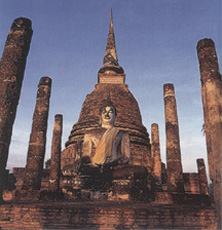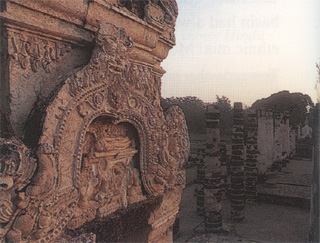|
|
|
Historical Setting
|
Sukhothai (13th - 15th Centuries)
The stale that is still regarded by
Thai historical tradition as the "first Thai
kingdom" was Sukhothai. There were
in lad, other contemporaneous Thai
states such as Lanna
and Phayao, both
in present-day northern Thailand, but the
Thai historical imagination has been
most stirred by Sukhothai. Even today,
the evocative ruins of Sukhothai and its
twin city Si Saichanalai conjure up
images of material prosperity, artistic
greatness, and Buddhist piety. Indeed.
Sukhothai is remembered as much for
its art and archiiecmre as for its political achievements.
 |
King Ramkhamhaeng's famous stone inscription, for the first time written in Thai,
survived intact through the centuries, and was discovered in Sukhothai by
King Mongkut during his monkhood
|
Sukhothai was originally a chief do in
under the sway of the Khmer empire;
the oldest monuments in the city were
built in the Khmer style or else show
clear Khmer in Hucnce. During the first
half of the 13th century the Thai rulers
of Sukhothai threw off the Khmer yoke
and set up an independent Thai kingdom.
One of the victorious Thai chieftains
becume the first king of Sukhothai.
with the name of Si Intharathit (Sri
Imdraditya). Sukhothai's power and
influence expanded in all directions
through conquest (the: Khmer were
driven southwards), by a far-sighted
network of marriage alliances with the
ruling families of other Thai states.
unil by the use of a common religion,
Theravada Buddhism, to cement relations
with other states.

Ruins of Sukhothai show Khmer architecture influence
|
Si Intharathit's son and successor
was King Ramkhamhaeng, undoubtedly
the most famous and dynamic monarch
ever to rule the Sukhothai kingdom.
Much of what we know about Sukhothai
in the 13th century derives from a 1292
stone inscription attributed to King Ramkhamhaeng. Though problematic,
the inscription is considered a seminal
source of Sukhothai history, as well
as a masterpiece of Thai lileraiure. It
eloquently extols the benevolence of
King Ramkhamhaeng's rule, the power
and prosperity of Sukhothai. The king
was accessible to his people; for
example, he had a bell hung in front
of the palace gale so that any subject
with a grievance could ring it and ask for justice:
"King Ramkhamhaeng, the ruler
of the kingdom, hears the call; he goes
and questions the man, examines the
cases and decides it justly for him. So
the people of Sukhothai praise him."
 |
King Ramkhamhaeng the Great, most famous ruler of Sukhothai
|
According to the inscription, the
king did nol levy road tolls or taxes on
merchandise, nor did he tax his subjects"
inheritance at all. Such a paternalistic
and benevolent style of kingship has
caused posterity to regard the Sukhothai
kingdom's heyday as a "golden age" in Thai history.
 |
Temples in the first Thai capital of Sukhothai are now past of an historical park
|
Even allowing for some hyperbole
in King Ramkhamhaeng's inscription,
it is probably true that Sukhothai was
prosperous and well-governed. Its
economy was self-sufficient, small-scale,
and agricultural. The Thai people's basic
diet was the same as that of many other
people in Southeast Asia. consisting of
rice and fish as staple foods, both of
which were plentiful according to the inscription:
"In the time of King Ramkhamhacng
this land of Sukhothai is thriving. There
are fish in the water and rice in the fields."

Temples in the first Thai capital of Sukhothai are now past of an historical park
|
Sukhothai may well have been
self-sufficient as far as food was
concerned, but its prosperity also
depended on commerce. During the
Sukhothai period glazed ceramic wares
known as "sanigkhalok" were produced
in great quantities at kilns in Sukhothai
and Si Satchanalai and exported regularly
to other countries in the South China Sea
area, specimens having been found in
Indonesia and the Philippines. Sukhothai
also traded with China through the
traditional Chinese tributary system: the
Thai king was content to send tribute to
the Chinese emperor and he classified
as a vassal, in return for permission
to sell Thai goods and buy Chinese products.

Sukhothai, where many distinctive aspects of Thai culture originated
|
Although animi.slic beliefs
remained potent in Sukhothai, King
Ramkhamhaeng and his successors
were all devout Buddhist rulers who
made merit on a large scale. The major
cities of the kingdom were therefore
full of monasteries, many of which were
splendid examples of Thai Buddhist
architecture. Sukhothai adopted the
Ceylonese school of Theravada Buddhism, beginning with
King Ramkhamhaeng's invitation to Ceylonese monks
to come and purify Buddhism in
his kingdom. The Ceylonese influence
manifested itself not only in matters of
doctrine but also in religious architecture.
The bell-shaped stupa. so familiar in
Thai Buddhist architecture, was derived
from Ceylonese models. Sukhothai-stye Buddha images are distinctive for their
elegance and stylized beauty, and
Sukhothai artists introduced the graceful
form of the "walking Buddha" into Buddhist sculpture.

Sukhothai Historical Park, now a World Heritage Site
|
Sukhothai's cultural importance
in Thai history also derives from the fact
thai the Thai script evolved into a definite
form during King Ramkhamhaeng's
time. taking as its models the ancient
Mon and Khmer scripts. Indeed, this
remarkable king is credited with having
invented the Thai script.
King Si Intharathit and King Ramkhamhaeng were boih warrior
kings and extended their territories far
and wide. Their successors, however,
could not maintain such a far-flung
empire. Some of these later kings were
more remarkable for their religious
piety and extensive building activities
than for their warlike exploits. An
example of this type of Buddhist ruler
was King Mahathammaracha Lithai,
believed to have been the compiler of
the Tribhumikatha, an early Thai book
on the Buddhist universe or cosmos.
The political decline of Sukhothai was,
however, not wholly due lo deficiencies
in leadership. It resulted rather from the
emergence of strong Thai states further
south, whose political and economic
power began to challenge Sukhothai
during the latier half of the 14th century.
These southern states, especially
Ayutthaya, were able to deny Sukhothai
access to the area.
The Sukhothai kingdom did not die
a quick death. Its decline lasted from the
mid-14th until the 15thentury. In 1378,
the Ayutthaya King Borommaracha I
subdued Sukhoihai's frontier city of
Chakangray (Kamphaengphet), and
thereafter Sukhothai became a tributary
stale of Ayutthaya. Sukhoihai attempted
lo break loose from Ayutthaya but with
no real success; in the 15th century it
was incorporated into the Ayutthaya
kingdom as a province. The focus of
Thai history and politics now moved
to the central plains of present-day Thailand. where Ayutthaya was establishing
ilself as a centralized stale, its power
outstripping not only Sukhothai but also
other neighbouring states such as
Suphannaphum and Lawo (Lopburi).
| | |
|
|